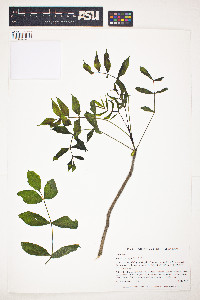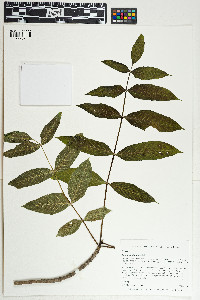|
|
|
|
Family: Oleaceae
black ash
|
Medium-sized tree 12 - 20 m tall, trunk diameter 30 cm - 0.6 m Leaves: opposite, pinnately compound, 25 - 40 cm long, with seven to eleven leaflets. Leaflets stalkless (except for the terminal), dark green above, paler and rusty-hairy along the veins beneath, 7 - 15 cm long, 2.5 - 5 cm wide, oblong to oblong lance-shaped with a tapering or rounded base and long-pointed tip, toothed, thin, and firm. Leaves turn reddish brown in autumn. Flowers: either male, female, or bisexual. They are usually found on separate trees but sometimes they are found on the same tree (polygamodioecious). The elongated, branched inflorescence contains small purplish flowers that lack petals. Fruit: dry, single-seeded, winged (samara), 2.5 - 4.5 cm long, oblong, and barely notched at the tip. Wing broad, often twisted, and extending to near the base of the flat seed cavity. Bark: ashy gray, thin, and fissured into soft, scaly plates that may flake off when rubbed. Twigs: stout, dark green, becoming light gray then dark gray and warty. Leaf scars oval, with several bundle scars forming a U. Buds: bluish black, small, conical, and finely hairy. Terminal bud 4 - 10 mm long and pointed. Uppermost pair of lateral buds up to 1 cm below the base of the terminal bud. Form: narrow and rounded with many stout, straight branches. Trunk often leaning or crooked, extending to the top of the crown. Similar species: The other ash species of the Chicago Region look more or less similar to Fraxinus nigra. Fraxinus americana differs by having short-stalked leaflets with pale or whitish undersides, twigs with raised leaf scars, and a twig surface (except current year's growth) that is flaky, scaly, or peeling. Also, the wing of its fruit does not extend to the base of the large seed cavity. Fraxinus pennsylvanica sometimes has densely hairy shoots, and the wing of its fruit encloses half or more of the seed cavity. Fraxinus profunda has conspicuously stalked leaflets, densely hairy shoots (current), and the wing of its fruit often extends to the base of the seed cavity. Fraxinus quadrangulata has square twigs, and the wing of its fruit extends to and around the base of the seed cavity. Flowering: late April to June, before the leaves Habitat and ecology: Local in moist woods, swamps, fens, floodplains, and other mesic sites. However, its most characteristic habitat is on calcareous springy slopes. Occurence in the Chicago region: native Notes: The wood of Fraxinus nigra is used for baskets, barrel hoops, woven chair bottoms, fence posts, cabinets, interior finish, and furniture. The emerald ash borer (Agrilus planipennis) is a serious insect threat to all native ashes (see link below). Etymology: Fraxinus is the Latin word for ash. Nigra is Latin for black, referring to its dark brown heartwood. Author: The Morton Arboretum Tree to 25 m; twigs glabrous, terete or nearly so; lfls 7-11, sessile, lanceolate to oblong, long-acuminate, often conspicuously serrate, broadly acute at base; fr flat, lanceolate to oblanceolate, 2.5-4 cm נ6-10 mm, the wing rounded to emarginate, extending nearly or quite to the base; no cal beneath the fr; 2n=46. Wet woods and swamps; Nf. and Que. to Man., s. to Del., W.Va., Ind., and Io. Gleason, Henry A. & Cronquist, Arthur J. 1991. Manual of vascular plants of northeastern United States and adjacent Canada. lxxv + 910 pp. ©The New York Botanical Garden. All rights reserved. Used by permission. |




